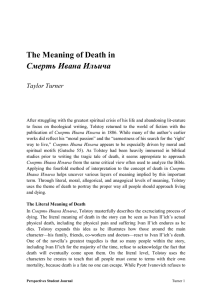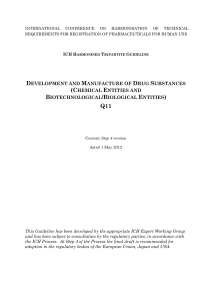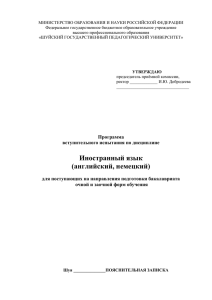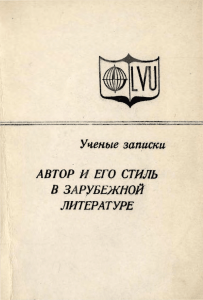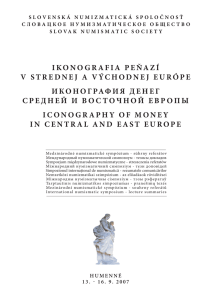Мобильные элементы и эволюция генома
реклама
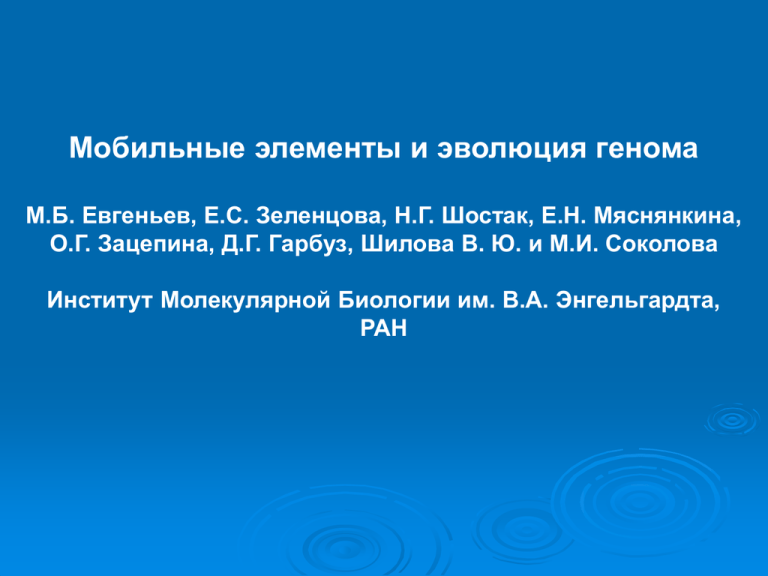
Мобильные элементы и эволюция генома М.Б. Евгеньев, Е.С. Зеленцова, Н.Г. Шостак, Е.Н. Мяснянкина, О.Г. Зацепина, Д.Г. Гарбуз, Шилова В. Ю. и М.И. Соколова Институт Молекулярной Биологии им. В.А. Энгельгардта, РАН Genome invasion or de novo formation Dynamics of invasion Multiplication Evolution Host defense Regulation Variability Genetic burden Deleterious effect Death Domestication Loss Maintenance Distribution in sequenced genomes Ectopic recombination Low recombination rate region Heterochromatin Low expression level region TE-products poisoning Low gene density region Genedisruption Gross morphology: ovaries Bilateral and unilateral sterile ovaries in dysgenic D.virilis Ovariole morphology: agametic ( in dysgenic ovaries) Drosophila virilis adult dysgenic testis Forming the primordial gonads in Drosophila virilis dysgenic 9 strain - wild type - control Reduction in pole cells in dysgenic embryos, cntd Drosophila virilis: whole mount hybridization with Penelope DNA probe 160 9 160x9 9x160 GT intron AG AT TG 5' cDNA fragment Penelope transcript XhoI EcoRI BamHI EcoRI XhoI 1 kb. Penelope, clone p6 Schematic representation of Penelope clone isolated from the genome of D.virilis. 5’fragment of cDNA with intron 75 b.p. length is shown above A ov+ th± D ov± th+ B ov+ th± F ov- th+ N ov- th+ O ov- th+ C ov+ th± P ov- th+ 1.0 .8 R ov- thS ov- th371 250 302 .4 (416 – 491) 416 1 .6 G ov- th∆ 369 416 371 .2 Intron 491 ORF Penelope 487 544 570 611 680 Regulatory elements - transcription start Promoter 850 Neptune 100 93 Penelope Penelope Xena branch 100 47 Poseidon 96 Tel H.sap Tel S.pom Telomerases retr S.ent Ec79 99 100 40 Ec110 88 94 62 Retrons Ec86 Ec67 Mat S.aga 100 Mat N.aro 99 61 Maturases Cox S.cer 100 Mat S.cer RT T.cru 90 TART-B2 59 RT L.pol 100 RT A.mar 69 94 Non-LTR retrortansposons RT R2Dm RT R2Nvi 71 Md M.mus RT C.alb 79 LTR retrortansposons Cre 2 HIV 1 Neighbor-joining tree based on the multiple alignment of 7 conserved motifs of reverse transcriptase domain Penelope – retrotransposon from D.virilis; Neptune – retrotransposon from Fugu rubripes; Poseidon - retrotransposon from Tetraodon nigroviridis; Xena retrotransposon from Takifugu rubripes 1224056 Penelope 1181450 2738435 3033368 2492912 2621722 2650260 586345 1175105 1176177 2635759 2621507 1174919 1770045 14037 2738528 1236427 2865254 H H A G A G * * * * * * 734 VVYQIPC4KC-NSVYIGTTKS---KLKTRISQHKSDFKLRHQ--NNIQKTALMTHCIRSNHTP-NFDETTI---------------LQQEQHYN 805 PBCV1 6 ChiV 5 coliphage T4 4 MJ0613_Mj 258 endoIII_Mth 23 endoIII_Af 3 YB78_YEAST 15 Y079_NPVAC 12 YHBQ_Ec 5 yurQ_Bs 45 UvrC_Mt 15 UvrC_Ec 19 UvrC_Bs 17 Intron Pa 18 Intron Aa 98 Intron Am 75 ORF_Ce 84 YFYIWIHKIS-GEKYVGITTQ---EIQQRLKAHCRKGNKC-----RRLRNAIQKHGVDAFD----VEYFEWC---------DPWDLAYIEGLLI YIYVIENNFD-NHVYIGSTVD---SLENRFRRHKADALKRPSC---LFHTYMKKHGVDNFVI-KLLKEVEII---------SILDLHLLEQNFI GIYQIKNTLN-NKVYVGSAKD----FEKRWKRHFKDLEKGCHS-SIKLQRSFNKHG-NVFEC-SILEEIPYE----------KDLIIERENFWI GKTERFFKKG-YYFYIGSAFGNSMNLKNRIERHLKD------------DKKMHWHIDYLLKY-GKIEEIYIT-------------NERVECEVA SLGTVRFPPG-FYVYVGSGFSS---LEARIKRHLSS------------EKRRRWHIDHFLDG-AEVECVLYT-----------TDKRRLECAVS ALGVIAFRRG-YYYYVGSANS----GVHRVKRHFSI------------KKKKRWHIDYISAK-MEVVGAILS--------------KEPECGLA CCYLLQSINKRQSFYVGSTPN----PVRRLRQHNGKLA---------VGGAYRTKRDGSR----PWEMIMIV-----RGFPSKIAALQFEHAWQ CVYILRQDNG--KLYTGITSN----LNRRIKQHSNK------------QGAKCLRNAT------NLRLVYHS-----ASAYDYNTAARMEYNLK FLYLIRTADN--KLYTGITTD----VERRYQQHQSG------------KGAKALRGKG------ELTLVFSA------PVGDRSLALRAEYRVK GIFMFYNIHD-ELLFVGKARK----LRQRIKKHFEDT-------------VSPIKHHRDEVY--KIEVCVVD--------------DPMEREIY GVYIFRDRDD-RVLYVGKSIS----IRKRVSSYFREQ------------ENPRLRIMMRHLE--SIEYILTQ--------------NEKEALIL GVYRMYDAGG-TVIYVGKAKD----LKKRLSSYFRSN-----------LASRKTEALVAQIQ--QIDVTVTH--------------TETEALLL GCYLMKDRQQ-TVIYVGKAKV----LKNRVRSYFTGS------------HDAKTQRLVTEIE--DFEYIVTS--------------SNLEALIL GIYMWTNKLN-GKKYVGSSVD----LRRRLSEYYNINRILNEK--SMPINVALLKYGYTNFTLTILEICDKD------------SLMSREKHFF GVYCLINKIN-GNAYVGSSIN----LASRMKNYLNNIFLKSKKNINMPIVKALLKYNQESFTLLILEYVEPN------------YLTIRETYYI GIYGIINNKT-NKIYIGSAVN----LHKRLVEHLYSDKT------NIRLQRSIGKDGLSSFSFIIFEYHDFN-DSILEFIDFNDLLLESETFYI GVYLIYDNLT-HDFYVGSAIT--NRINVRFRNHCIHKSG------SSLVAKAIQKSGLENFDFYILEYFHGFVHKENQKKDQLE-LLKRETYYL 77 81 79 324 88 64 86 76 68 104 75 80 77 92 174 156 167 Fig. Multiple alignment of the C-terminal region of Penelope with a selection of GIY-YIG domain endonucleases. * shows the positions of conservative AA residues selected for mutagenesis of Penelone endonuclese catalytic domain. Substituted AA residues are shown above (Y736H, Y750H, R761A, H782G, D793A, E801G). 1 2 3 4 5 kDa 220 97 67 46 30 20 Purification of Penelope protein from Spodoptera frugiperda cells infected by baculovirus containing Penelope ORF Penelope protein was purified by multiple step chromatography using: 2) phosphocellulose P11 (Whatman); 3) – heparin-sepharose (Pharmacia); 4) - MonoS (FPLC, Pharmacia) and 5) - concentrated using 50 kDa Centricon (Millipore) Изучение влияния мутаций по rasiRNA-зависимому пути на количество транскриптов мобильного элемента Рenelope с использованием метода RT-PCR -/- Pen rp49 armi Pen +/- +/+ -/Pen rp49 18 Penelope(A1) 16 14 12 -/+/Penelope (1) 10 8 6 4 -/- 2 +/- 0 Количество транскриптов мобильного элемента Penelope на фоне мутации armitage уровень экспрессии spn-e Pen +/- уровень экспрессии Количество транскриптов мобильного элемента Penelope на фоне мутации spn-e 16 14 12 10 8 6 4 2 0 Penelope(A1) -/+/+ +/Penelope (1) -/- +/+ +/- Table 1. Phylum 10 Class Species 18 about 100 (e.g. Protista, Rotifera, (e.g. Crustacea, Amphibia, Arthropoda, Chordata) Echinoidea, Insecta) PLEs Penelope, Athena, Cercyon, Bridge, Xena pUC-8 K E K S E white X 5'P H S pUC-8 E PenORF K X Pr S S 3'P X white Pr white S Penelope ORF 3'P HS C X H S B XE E Penelope p6 3'P HS K E S A X S HS 5'P H pUC-8 5'P 1kb Schematic representation of the structure of Penelope copies integrated into D. melanogaster genome DNA construction containing A) full length Penelope clone p6; B) full length Penelope ORF under control heat shock promoter of D.melanogaster; C) Penelope ORF with a deletion of 5' region under control heat shock promoter of D.melanogaster. Arrows with 3'P and 5'P mean 3'P and 5'P inverted repeats of P element, respectively. Arrow with Pr displays a Hsp70Bb heat shock promoter of D.melanogaster. The symbols indicated above correspond the restriction sites (X, H, E, S and K represent XhoI, HindIII, EcoRI, SalI and KpnI, respectively) S X X H S HS pUC-8 3'P Penelope p6 white 5'P 8,5 kb kb. 1 2 3 4 5 6 7 8 9 10 11 12 13 14 15 10.0 8.0 6.0 5.0 4.0 3.0 2.5 2.0 1.5 1.0 Southern blot hybridization of transformed D.melanogaster strains with Penelope probe Lanes 1-3 initial strain Df(I)w, yw67c23(2); lanes 4-6; 7-9 strains transformed with Penelope ORF under control of heat shock promoter; 10-12; 13-15; strains transformed with full length Penelope copy (p6). Lanes 1- 4; 7; 10; 13 genomic DNA digested by XhoI; lanes 2; 5; 8; 11; 14 genomic DNA digested by Hind III; lanes 3; 6; 9; 12; 15 genomic DNA digested by Sal I B А Results of in situ hybridization of polytene chromosomes of flies D.melanogaster transformed by Penelope-containing clone (p6) А - in situ hybridization with "mini-white"; B - hybridisation with Penelope. Hybridization sites are shown by arrows Results of in situ hybridization of polytene chromosomes of flies D.melanogaster transformed by Penelope-containing clone (p6) Strain Strain A Established in October, 1999 Tested March, 2000 Tested September, 2000 Sites of Original Construct Insertion Number of Penelope transposition 3B (Ich.); 18A (Ich.) 3B (Ich.); 18A (Ich.) _ 3B (Ich.); 18A (Ich.) Strain B Established in 6E (Ich.); October, 1999 96F (IIIR ch.) Tested 6E (Ich.); September, 2000 96F (IIIR ch.) ch – means chromosoma 4 9 (new) All sites where Penelope insertions were found 21C, 6E, 54F, 100F 22F, 70D, 100B, 55A, 54A, 28E, 95E, 56C, 92D (13 total) _ 5 17F, 24A, 51B, 55F, 57B (5 total) Drosophila melanogaster transformation with the Penelope transposable element Sterile ovaries Agametic ovarioles The design of localization of EPgy2 insertions into hsp70Aa and hsp70Ab genes in strains with US-4 and US-2. Number of primers is indicated. EPgy2 6 3 1 2 hsp70Aa 4 4 hsp70Ab 2 1 54 7 5 CG18347 CG3281 aur 3 55 5 6 7 EPgy2 5 5 CG12213 53 P-element construct hsp70Aa hsp70Ab ∆2-3 EPgy2 ♀ Yw Yw P(y+w+) yw Df yw yw ♀ yw + + Df ♂ X + + ♀ ∆2-3 P(y+w+) X yw ♂ X yw P(y+w+) ∆2-3 P(y+w+) ♂ + + + P(y w ) P(y+w+) n yw X + Selection of males with enhanced eye color yw P(y+w+) P(y+w+) n yw P(y+w+) P(y+w+) ♀ X ♂ yw + + Selection of strains, containing additional copies of construction n Southern-hybridization of genome DNA from heterozygous transformants with 5’ (up) and 3’ (down) fragments of D. melanogaster hsp70 (HindIII-BamHI) 4.3 kb Bbb 3.3 kb Bb+Bc 2.5 kb Aa 2.1 kb Ba 1.8 kb Ab 4.4 Bc 4.3 Ab, Bb 2.0 Aa, Ba 57% Strains from US-2 hsp70Aa hsp70Ab 43% -229(1) 200(1) -135(4) -97(3) +1 H H g -160(1) g g H g -96(3) H g -40(1) T 87% Strains from US-4 hsp70Aa hsp70Ab 13% CGGCGCAC target duplication -240(1) -174(1) -137(1) -135(4) -97(12) -42(2) -28(1) +1 H H g g -144(1) g H g -96(5) H g T -40(1) GGCGCACT target duplication Сравнение экспериментальной и естественной транспозиции ВЫВОДЫ МОБИЛЬНЫЕ ЭЛЕМЕНТЫ СОСТАВЛЯЮТ ЗНАЧИТЕЛЬНУЮ ПРОПОРЦИЮ ГЕНОМА ВСЕХ ИЗУЧЕННЫХ ОРГАНИЗМОВ. ПРИ ПРОВЕДЕНИИ ОПРЕДЕЛЕННЫХ СКРЕЩИВАНИЙ ПРОИСХОДИТ АМПЛИФИКАЦИЯ И МАССОВЫЕ ТРАНСПОЗИЦИИ ОПРЕДЕЛЁННЫХ СЕМЕЙСТВ МОБИЛЬНЫХ ЭЛЕМЕНТОВ («СИНДРОМ ГИБРИДНОГО ДИСГЕНЕЗА»). ВЫСОКИЙ УРОВЕНЬ ГЕНЕТИЧЕСКОГО ПОЛИМОРФИЗМА, ВОЗНИКАЮЩИЙ ПРИ СИНДРОМ ГИБРИДНОГО ДИСГЕНЕЗА, МОЖЕТ СЛУЖИТЬ МАТЕРИАЛОМ ДЛЯ ОТБОРА, ПРИВОДЯ К БЫСТРОМУ, «ВЗРЫВНОМУ» ВИДООБРАЗОВАНИЮ.

